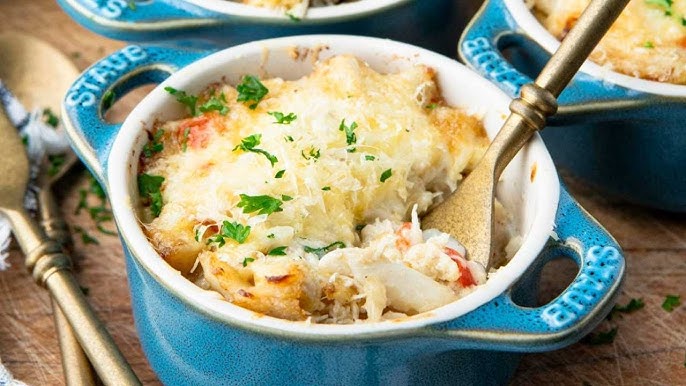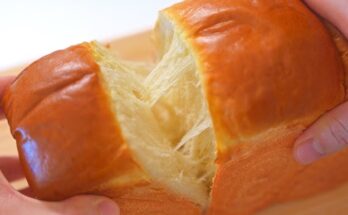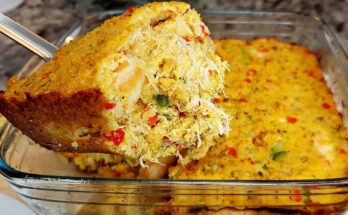Crab Imperial Recipe: Crab Imperial is the kind of dish that whispers elegance and indulgence with every bite. It’s a creamy, rich seafood casserole baked to golden perfection, with a flavor that instantly transports you to the shores of the Chesapeake Bay. While it might look fancy and restaurant-worthy, the beauty of Crab Imperial lies in its simplicity—minimal ingredients, minimal effort, and maximum flavor.
Originating on the East Coast, especially in Maryland, this dish has earned a permanent place in seafood lovers’ hearts. Think of it as crab cakes’ refined cousin—less filler, more flavor, and absolutely no frying. It’s traditionally served in scallop shells or ramekins, making it perfect for dinner parties or a cozy seafood dinner at home.
What makes Crab Imperial so special? The star ingredient, of course—lump crab meat. It’s gently folded into a seasoned mayo-based sauce, then baked just enough to set and brown slightly on top. The result? Juicy, flavorful crab with a golden, slightly crusted top layer. Whether you’re impressing guests or treating yourself, this dish is a showstopper in every sense.
Ingredients You’ll Need
Let’s break down what goes into making the perfect Crab Imperial. The list is short but powerful—each ingredient plays a key role in creating that signature creamy, savory, slightly tangy profile.
Fresh Lump Crab Meat
The absolute heart of the dish. You’ll want to use the best quality lump crab meat you can get your hands on. Jumbo lump is even better if your budget allows, but regular lump meat is fantastic. Avoid imitation crab at all costs—this dish deserves the real deal.
Look for:
- Pasteurized crab meat in tubs (usually in the refrigerated section)
- Freshly picked meat from steamed blue crabs (if you’re lucky enough to live near the coast)
- Canned lump crab meat as a last resort, but make sure it’s labeled “lump” and not “flake” or “special”
One pound is a standard amount for four generous servings.
Binding and Flavoring Agents
Here’s where the magic begins. You don’t want a heavy, breaded mixture like a crab cake. The sauce should gently coat the crab meat without overpowering it.
You’ll need:
- Mayonnaise: The creamy base. Use a good quality full-fat version.
- Egg: Acts as a binder without turning the dish into a frittata.
- Dijon mustard or regular mustard: Adds tang and depth.
- Lemon juice: Brightens up the richness.
- Worcestershire sauce: A little umami never hurt anyone.
- Old Bay seasoning: Because, Maryland. It’s practically a requirement.
- Parsley: Adds freshness and a pop of color.
Optional but popular additions:
- A dash of hot sauce for some gentle heat
- Minced shallots or onions for texture
- Garlic powder for extra punch
Optional Add-ons for Extra Flavor
Want to take things up a notch? Consider folding in a bit of grated Parmesan, or topping the dish with breadcrumbs for that extra golden crunch. These aren’t traditional, but they’re delicious.
Topping ideas:
- A sprinkle of paprika before baking for color
- A handful of crushed Ritz crackers mixed with melted butter
- A light grating of cheddar or Gruyère cheese on top
Use your creativity, but always let the crab shine through.
Kitchen Tools You’ll Need
You don’t need a high-end kitchen to whip up Crab Imperial, but having the right tools can make prep and cleanup a breeze.
Essentials include:
- Mixing bowls: One medium-sized bowl should do the trick.
- Whisk and spatula: For mixing the sauce and folding in the crab gently.
- Ramekins or a baking dish: Traditionalists use individual ramekins or scallop shells. You can also use a small casserole dish if you’re serving it family-style.
- Baking tray: If you’re using ramekins or shells, place them on a tray for easier transfer in and out of the oven.
- Oven: Preheat to 375°F (190°C) before baking.
Tips for cleanup:
- Lightly grease your ramekins or baking dish to avoid sticking.
- Use parchment paper on your baking tray for easy cleanup if there are any spills.
- If you’re using real crab shells or scallop shells for presentation, give them a good scrub first.
Preparing the Crab Meat
This step is crucial. Crab meat is delicate, and how you handle it can make or break your final dish.
How to Pick and Handle Fresh Crab Meat
Start by gently draining the crab meat. It often comes in a bit of liquid to preserve freshness, but excess moisture can ruin your creamy base. Place it in a colander for a few minutes, or gently pat with paper towels.
If you’re picking the meat yourself from steamed crabs:
- Make sure your hands are clean.
- Use a crab mallet or small knife to access the chambers.
- Be meticulous—take your time to extract the lump portions.
Never shred or overwork the crab meat. The large lumps are what give Crab Imperial its luxe texture and appeal.
Checking for Shells and Ensuring Quality
Even high-quality crab meat can have bits of shell or cartilage. Carefully go through the meat with your fingers, feeling for any hard pieces.
Things to watch out for:
- Translucent bits of shell (they’re sharp!)
- Cartilage (often from the body sections)
- Off smells (fresh crab should smell slightly sweet and oceanic)
Once picked and checked, place the meat in a bowl and cover it with a damp paper towel until you’re ready to mix it with the sauce. This keeps it from drying out.
Making the Imperial Sauce
The secret behind any unforgettable Crab Imperial lies in its sauce—a luscious, velvety mix that binds everything together without stealing the show. You want it rich, flavorful, and balanced enough to enhance the sweet crab meat, not bury it.
The Creamy Base – Mayonnaise and Beyond
Mayonnaise is the main star here. It’s what gives the sauce its creamy, moist texture. Use a full-fat version for the best result—light mayo just doesn’t give the same depth or richness.
Here’s what you’ll need for the sauce:
- 1/2 cup mayonnaise (Duke’s or Hellmann’s are popular choices)
- 1 large egg (lightly beaten)
- 1 tablespoon Dijon mustard (adds a subtle tang)
- 1 teaspoon Worcestershire sauce (for umami)
- 1 tablespoon fresh lemon juice (brightens the flavor)
- 1 teaspoon Old Bay seasoning (adds signature Maryland flavor)
- 1/4 teaspoon salt and pepper to taste
- Optional: a dash of hot sauce for heat, 1/2 teaspoon sugar to balance acidity
Whisk everything together in a bowl until it’s smooth and fully combined. You’re aiming for a consistency that’s thick but not gloopy—something that will coat the crab gently without drowning it.
A trick to remember: let the sauce sit for 10 minutes before mixing it with the crab. It allows the flavors to meld and gives a deeper, more rounded taste.
Seasonings that Make the Dish Pop
Seasoning is where you can put your personal touch on the recipe. Want it zestier? Add more lemon juice. Need some kick? A few drops of your favorite hot sauce or cayenne pepper can liven it up. You could even fold in a bit of finely chopped tarragon or dill for a more herbaceous note.
Some other optional enhancements:
- Chopped fresh parsley – Bright and aromatic
- Minced garlic or garlic powder – Adds punch
- Paprika – For a smoky hint and beautiful color
Once your sauce is seasoned to your liking, the next step is key—folding in the crab meat. Use a spatula or large spoon to gently combine the two. Be super careful not to break up the crab lumps. It’s more of a “fold and lift” motion than a stir.
Assembling the Crab Imperial
With your seasoned sauce ready and your crab meat perfectly prepped, it’s time to bring it all together and assemble your dish.
Folding the Crab into the Sauce
Remember, crab meat is delicate. You don’t want to overmix it or break down those beautiful lumps. The goal is to get every piece of crab lightly coated without making it mushy.
Here’s how to do it:
- Pour about 2/3 of the sauce over the crab meat in a mixing bowl.
- Using a spatula, gently fold the mixture. Turn it over in sections rather than stirring.
- Add more sauce if needed, but avoid saturating it.
- The finished mixture should be creamy but still hold its shape when spooned out.
Resist the urge to mash or stir hard. Treat the crab with care—it deserves it.
Portioning into Ramekins or Baking Dish
Now for the fun part—putting it all together:
- If using ramekins or scallop shells: Spoon the mixture evenly into each one. You should get about 4 to 6 portions depending on size.
- If using a single casserole dish: Spread the mixture into the dish in an even layer.
You can lightly grease the ramekins if you’re worried about sticking, but with the amount of mayo in the mixture, it’s rarely an issue.
Adding the Final Touches Before Baking
This is where you can add your own twist to the top. Want a crispy topping? Try one of these options:
- Breadcrumbs + melted butter – Classic and crunchy
- Ritz cracker crumbs – Buttery and nostalgic
- Grated Parmesan or cheddar – For that extra golden top
- Paprika – Adds color without affecting taste too much
Sprinkle your topping of choice over the mixture, and then you’re ready for the oven.
Baking Your Crab Imperial to Perfection
This dish doesn’t need a long bake—just enough to heat through and brown slightly on top.
Oven Time and Temperature
Preheat your oven to 375°F (190°C). This is the sweet spot that allows the top to brown nicely while gently warming the crab and setting the egg in the mixture.
Bake for:
- Ramekins: 20–25 minutes
- Casserole dish: 25–30 minutes
You’re looking for:
- A light golden crust on top
- Bubbly edges
- An internal temp of 160°F if you’re using a thermometer
Avoid overbaking—it’ll dry out the crab. If you want an extra golden top, you can broil it for the last 1–2 minutes, but watch closely to avoid burning.
Serving Suggestions
Let it cool for 5 minutes before serving. It sets up just slightly and becomes easier to spoon or eat from the ramekin.
Serve with:
- A side salad with vinaigrette to cut the richness
- Steamed asparagus or green beans
- Toasted baguette or crusty rolls
- A chilled glass of white wine (Sauvignon Blanc or Chardonnay)
This dish is elegant but unfussy—perfect for both weeknight dinners and fancy dinner parties.
Tips for Making the Perfect Crab Imperial
Even though Crab Imperial is straightforward, a few pro tips can take your dish from good to exceptional. It’s all about enhancing the crab’s natural flavor while avoiding common mistakes.
Choose Quality Crab Meat
This can’t be stressed enough—use the freshest, highest-quality lump crab meat available to you. Pasteurized crab meat from the refrigerated section is fine, but if you can get fresh-picked blue crab meat, even better. Avoid canned or imitation crab, which lacks the sweet, delicate flavor this dish needs.
Also, try to keep the lumps intact while mixing. Those big, meaty bites are what Crab Imperial is all about.
Don’t Overdo the Seasoning
Remember, the crab is the star. It’s tempting to add extra garlic, onions, or spices, but too much can mask the delicate seafood flavor. Stick with simple, clean seasoning—just enough to enhance, not overpower.
Use Ramekins for Individual Servings
Ramekins not only make your dish look fancy, but they also ensure even cooking and a golden, crispy top. If you’re entertaining, they also help with portion control and presentation. Plus, everyone loves their own personal serving!
Prep Ahead if Needed
Crab Imperial is a great make-ahead dish. You can mix the crab and sauce and portion it into ramekins a few hours before baking. Just cover and refrigerate until ready to cook. When you’re ready, pop it into the oven and serve fresh.
Common Mistakes to Avoid
Let’s be real—there’s nothing worse than wasting good crab on a poorly executed recipe. Here are a few common pitfalls to steer clear of when making Crab Imperial.
Using Too Much Mayo
Yes, mayo is the base, but too much can make your dish greasy and heavy. Use just enough to bind the ingredients together. You want a creamy consistency, not a mayonnaise soup.
Overmixing the Crab Meat
The golden rule: fold, don’t stir. Overmixing will break up the precious lump crab meat, turning your dish into a crab mush. It won’t affect the flavor, but you’ll lose the luxurious texture that makes Crab Imperial so special.
Overbaking
Crab meat cooks quickly, and baking it too long will dry it out. Stick to the recommended bake time (20–25 minutes) and keep an eye on it during the final minutes. If you want a browner top, use the broiler sparingly—30 seconds too long can ruin it.
Not Tasting the Sauce Before Mixing
Before you fold in the crab, always taste the sauce. You can’t adjust seasoning once the crab is added without overmixing. Make sure it’s balanced—salty, tangy, and just a little zippy.
Storing and Reheating Leftovers
Crab Imperial is best eaten fresh, but if you have leftovers (lucky you!), here’s how to store and enjoy them later.
Refrigeration
Let the dish cool completely, then cover tightly with plastic wrap or transfer it to an airtight container. Store in the fridge for up to 2 days.
Avoid storing it for longer—crab is delicate, and the flavors and texture start to decline after a couple of days.
Freezing
Freezing isn’t recommended. The mayo-based sauce can separate, and the crab meat tends to get rubbery after thawing. If you must freeze it, do so before baking. Wrap tightly and label it, then bake straight from frozen, adding 10–15 minutes to the baking time.
Reheating
To reheat, preheat your oven to 325°F and cover the dish with foil to prevent drying out. Bake for about 15–20 minutes, or until heated through.
Avoid the microwave—it’ll overcook the crab and ruin the texture.
Variations to Try
Crab Imperial is fantastic on its own, but once you’ve mastered the classic, why not mix things up a bit?
Crab-Stuffed Seafood
Use your Crab Imperial mixture to stuff:
- Shrimp – Large butterflied shrimp with a scoop of Imperial on top
- Lobster tails – A fancy twist that’s restaurant-worthy
- Fish fillets – Flaky white fish like flounder or tilapia work great
Just stuff, bake, and enjoy the compliments.
Crab Imperial Dip
Turn this into a crowd-pleasing appetizer by serving it as a warm dip with crostini or crackers. Simply bake the mixture in a shallow dish and top with cheese and breadcrumbs for extra crunch.
Spicy Crab Imperial
For a bold, spicy version, add:
- Chopped jalapeños or serrano peppers
- A dash of cayenne or chili flakes
- A splash of hot sauce or sriracha
The heat pairs beautifully with the creamy base and sweet crab.
FAQs about Crab Imperial Recipe
Q1: What is Crab Imperial made of?
Crab Imperial is a classic seafood dish made with lump crab meat, mayonnaise, eggs, Dijon mustard, lemon juice, Worcestershire sauce, and seasonings. It’s typically baked until golden and served as a rich, creamy entrée.
Q2: Can I use imitation crab meat for this recipe?
Technically yes, but it’s not recommended. For that authentic, buttery flavor and flaky texture, real lump or jumbo lump crab meat is the gold standard.
Q3: What type of crab meat is best?
Jumbo lump crab meat is best for presentation and taste, but backfin or lump crab meat also works well for a more budget-friendly option.
Q4: How long does it take to bake Crab Imperial?
Generally, it bakes for about 20–25 minutes at 350°F (175°C), or until the top is lightly browned and bubbly.
Q5: Can I make it ahead of time?
Yes! You can prepare the mixture ahead, refrigerate it for up to 24 hours, and then bake it just before serving. Perfect for dinner parties or holidays.
Q6: Is Crab Imperial gluten-free?
It can be! Just make sure your Worcestershire sauce and any optional breadcrumbs are gluten-free.
Q7: What should I serve with Crab Imperial?
It pairs beautifully with roasted vegetables, wild rice, garlic mashed potatoes, or even a fresh garden salad for a lighter option.
Q8: How do I store leftovers?
Keep leftovers in an airtight container in the fridge for up to 3 days. Reheat gently in the oven for best results.
Q9: Can I freeze Crab Imperial?
Freezing isn’t ideal as it may alter the creamy texture. It’s best enjoyed fresh or from the fridge within a few days.
Q10: What wine goes well with Crab Imperial?
A crisp white wine like Chardonnay, Sauvignon Blanc, or Pinot Grigio complements the richness of the dish perfectly.
Conclusion
Crab Imperial is one of those dishes that’s both timeless and incredibly rewarding. With its creamy texture, rich flavors, and elegant presentation, it’s no wonder this East Coast favorite has been around for generations. Whether you’re serving it for a dinner party or just treating yourself on a weeknight, this recipe delivers restaurant-quality results with very little effort.
By using fresh crab meat, keeping the seasoning simple, and baking it just right, you can create a dish that impresses every time. And the best part? It’s endlessly versatile—dress it up, make it spicy, or serve it as a dip. Once you’ve tried it, Crab Imperial might just become your new go-to seafood dish.



